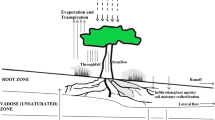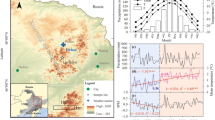Abstract
Plant transpiration is strongly constrained by hydraulic architecture, which determines the critical threshold for cavitation. Because species vary greatly in vulnerability to cavitation, hydraulic limits to transpiration and stomatal conductance have not generally been incorporated into ecological and climate models. We measured sap flow, leaf transpiration, and vulnerability to cavitation of a variety of tree species in a well-irrigated but semi-arid urban environment in order to evaluate the generality of stomatal responses to high atmospheric vapor pressure deficit (D). We found evidence of broad patterns of stomatal responses to humidity based on systematic differences in vulnerability to cavitation. Ring-porous taxa consistently had vulnerable xylem and showed strong regulation of transpiration in response to D, while diffuse-porous taxa were less vulnerable and transpiration increased nearly linearly with D. These results correspond well to patterns in the distribution of the taxa, such as the prevalence of diffuse-porous species in riparian ecosystems, and also provide a means of representing maximum transpiration rates at varying D in broad categories of trees.







Similar content being viewed by others
References
Abrams MD (1990) Adaptations and responses to drought in Quercus species of North America. Tree Physiol 7:227–238
Alder NN, Pockman WT, Sperry JS, Nuismer S (1997) Use of centrifugal force in the study of xylem cavitation. J Exp Bot 48:665–674
Alder WJ, et al. (1998) Climate of Salt Lake City, UT. In: NOAA technical memorandum NRS WR-152
Bovard BD, Curtis PS, Vogel CS, Su H-B, Schmid HP (2005) Environmental controls on sap flow in a northern hardwood forest. Tree Physiol 25:31–38
Buckley TH (2005) The control of stomata by water balance. New Phytol 168:275–292
Burns RM, Honkala BH (1990) Silvics of North America. USDA Forest Service, Washington
Catovsky S, Holbrook NM, Bazzaz FA (2002) Coupling whole-tree transpiration and canopy photosynthesis in coniferous and broad-leaved tree species. Can J For Res 32:295–309
Clearwater MJ, Meinzer FC, Abbadie L, Andrade JL, Goldstein G, Holbrook NM (1999) Potential errors in measurement of nonuniform sap flow using heat dissipation probes. Tree Physiol 19:681–687
Daley MJ, Phillips NG (2006) Interspecific variation in nighttime transpiration and stomatal conductance in a mixed New England deciduous forest. Tree Physiol 26:411–419
Franks PJ, Farquhar GD (1999) A relationship between humidity response, growth form, and photosynthetic operating point in C3 plants. Plant Cell Environ 22:1337–1349
Goulden ML, Field CB (1994) Three methods for monitoring the gas exchange of individual tree canopies: ventilated-chamber, sap-flow and Penman-Monteith measurements on evergreen oaks. Funct Ecol 8:125–135
Granier A (1987) Evaluation of transpiration in a Douglas-fir stand by means of sap flow measurements. Tree physiol 3:309–320
Granier A et al (1994) Axial and radial water flow in the trunks of oak trees: a quantitative and qualitative analysis. Tree Physiol 14:1383–1396
Hacke UG, Sperry JS, Wheeler JK, Castro L (2006) Scaling of angiosperm xylem structure with safety and efficiency. Tree Physiol 26:689–701
Hultine KR, Bush SE, West AG, Ehleringer JR (2007) Effect of gender on sap-flux-scaled transpiration in a dominant riparian tree species: Box elder (Acer negundo). J Geophys Res 112:G03S06. doi:10.1029/2006JG000232
Li Y, Sperry JS, Taneda H, Bush SE, Hacke UG (2007) Evaluation of centrifugal methods for measuring xylem cavitation in conifers, diffuse- and ring-porous angiosperms. New Phytol 177:558-568
Lu P, Urban L, Ping Z (2004) Granier’s thermal dissipation probe (TDP) method for measuring sap flow in trees: theory and practice. Acta Bot Sin 46:631–646
Nowak DJ, Rowntree RA, McPherson EG, Sisinni SM, Kerkmann ER, Stevens JC (1996) Measuring and analyzing urban tree cover. Landsc Urban Plan 36:49–57
Oren R, Pataki DE (2001) Transpiration in response to variation in microclimate and soil moisture in southeastern deciduous forests. Oecologia 127:549–559
Oren R et al (1999) Survey and synthesis of intra- and interspecific variation in stomatal sensitivity to vapour pressure deficit. Plant Cell Environ 22:1515–1526
Pallardy SG, Rhoads JL (1993) Morphological adaptations to drought in seedlings of deciduous angiosperms. Can J For Res 23:1766–1774
Pataki DE, Oren R (2003) Species differences in stomatal control of water loss at the canopy scale in a mature bottomland deciduous forest. Adv Water Resour 26:1267–1278
Pataki DE, Oren R, Smith WK (2000) Sap flux of co-occurring species in a western subalpine forest during seasonal soil drought. Ecology 81:2557–2566
Phillips N, Oren R, Zimmerman R (1996) Radial patterns of xylem sap flow in non-, diffuse- and ring-porous tree species. Plant Cell Environ 19:983–990
Sperry JS (2000) Hydraulic constraints on plant gas exchange. Agric For Meteorol 104:13–23
Sperry JS, Adler FR, Campbell GS, Compstock JP (1998) Limitation of plant water use by rhizosphere and xylem conductance: results from a model. Plant Cell Environ 21:347–359
Tyree MT, Zimmerman MH (2002) Xylem structure and the ascent of sap. Springer, New York
Acknowledgements
We thank Tim Dance and Angela Allred for their assistance with fieldwork and sensor construction. This work was funded by the U.S. National Science Foundation grants ATM-02157658 and IBN-0416297.
Author information
Authors and Affiliations
Corresponding author
Additional information
Communicated by Manuel Lerdau.
Rights and permissions
About this article
Cite this article
Bush, S.E., Pataki, D.E., Hultine, K.R. et al. Wood anatomy constrains stomatal responses to atmospheric vapor pressure deficit in irrigated, urban trees. Oecologia 156, 13–20 (2008). https://doi.org/10.1007/s00442-008-0966-5
Received:
Accepted:
Published:
Issue Date:
DOI: https://doi.org/10.1007/s00442-008-0966-5




